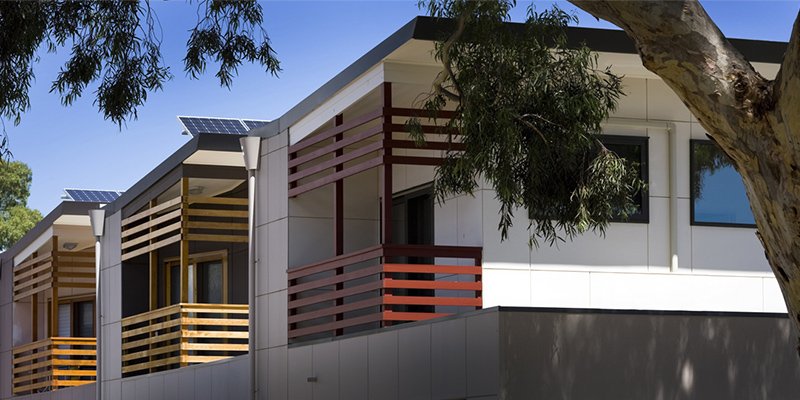New multilevel homes become heat traps in summer
By Candy Gibson
 ENVIRONMENT AND SUSTAINABILITY The top floor of some of Lochiel Park’s energy efficient homes can be like a furnace in summer, a UniSA study has found.
ENVIRONMENT AND SUSTAINABILITY The top floor of some of Lochiel Park’s energy efficient homes can be like a furnace in summer, a UniSA study has found.Fancy a new, two-storey energy efficient home? If you assume that all the rooms in your highly energy-rated home will be comfortable, think again.
A study of 7.5‑star rated homes in Lochiel Park – built for its sustainable living – has revealed many of its top-floor rooms are like furnaces in summer.
While previous monitoring and resident surveys carried out by UniSA researchers from the Barbara Hardy Institute have demonstrated the reduced energy bills and improved thermal comfort of homes in Lochiel Park, this is not necessarily the case for upper floor rooms during heatwaves.
UniSA engineering PhD candidate and architect Sormeh Sharifi, found that top floors in the model green village exceeded 32 degrees for 21 per cent of the summer days, regardless of whether they had air conditioning.
And the experience is not restricted to Lochiel Park, Adelaide, or even Australia. Overheating in multilevel homes is a global issue, it seems.
Sharifi, a senior architect with more than 16 years’ experience in the industry, says the combination of global warming, insufficient insulation in ceilings or roofs in new residential buildings and newly-built airtight homes which don’t allow for any ventilation, are partly to blame.
“Energy efficiency and thermal comfort do not necessarily go together,” she says. “A house can be designed to use minimal energy across a whole year, but still struggle in peak summer temperatures.”
Sharifi says it should be possible to design a home that is both energy efficient and comfortable, but it depends on the architectural design and the right features.
In Adelaide’s case – and across much of Australia – homes are designed based on imported architectural principles that have no bearing on local climatic conditions, she argues.
“Everyone agrees that Adelaide has a Mediterranean climate but how many homes do we see here that are correctly oriented and allow for natural ventilation, like many Mediterranean buildings?
“The pitch of roofs is based on the construction materials and the rainfall. The rainfall in Adelaide does not lead to a pitched or skillion roof; rather the water can be collected by a minor slope.”
Despite improved standards for energy efficiency in refurbished or newly-built homes, the top floor temperatures in multilevel houses are mostly higher than accepted building standards.
A 2014 survey carried out among 25 householders in Lochiel Park found that 23 of them (92 per cent) reported that while their homes were generally comfortable and required less air conditioning, the upstairs areas were uncomfortable in summer, with many residents having to sleep on the ground floor on hot nights.
With a projected 32 per cent increase in electricity usage to cool Adelaide’s homes in the next decade, the pressure is on to find a solution.
Sharifi says more advanced software is needed to ensure the temperature is evenly distributed over multilevel dwellings in Australia.
“Other techniques such as shading, orientation, thermal insulation, lighter colours and the correct building materials would help to solve the problem.
“It’s also pointless to just blame developers and builders for taking short cuts to maximise their profits. We need to get the right architecture. It’s not so hard; we just need to change our approach.”
Her paper, “Identification of overheating in the top floors of energy-efficient multi-level dwellings”, has recently been published in the Energy and Buildings international journal and can be accessed in ScienceDirect.
Other Stories
- UniSA researchers to help NASA monitor health in space
- Great career prospects for UniSA graduates, new government data shows
- Parents left in the cold when it comes to kids with autism
- New multilevel homes become heat traps in summer
- From the Vice Chancellor
- Achievements and Announcements
- World first study with drone cameras able to identify survivors
- Wastewater study pinpoints cities across the world with high drug use
- UniSA ranked top in SA for Education, Law, Business and Economics
- Opportunity for almost 200 UniSA students to study in Indo-Pacific in 2020
- Intensive course empowers women impacted by domestic violence and homelessness
- The magic that happens when a nanoengineer and immunologist collaborate
- UniSA takes reins on world first Invictus Pathways Program for Aussie veterans and first responders
- New Social Enterprise Hub to foster social innovation and entrepreneurship
- New partnership with MIT to underpin data visualisation research
- UniSA Vietnamese law student wins SA’s top honour
- The latest books from UniSA researchers
- UniSA Alumni Awards and UniSA Research Day
- Australia’s drought relief package hits the political spot but misses the bigger point
- Relive the Hawke Centre’s latest events
- Read the latest edition of unisabusiness magazine
- Read the latest edition of enterprise magazine




